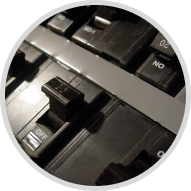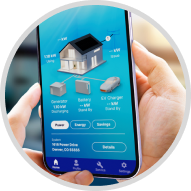

You don’t interact with solar panels the way you might with other large home appliances, like a dishwasher or an HVAC. They’re quiet, self-sufficient, rooftop workhorses designed to withstand the elements.
So how are you supposed to know if your solar panels are working properly?
That’s where proper troubleshooting and a solar panel monitoring system come in.
What’s a Solar Panel Monitoring System?

A solar panel monitoring system uses sensor hardware and software that connects to the panels and produces data, allowing owners to track, visualize and, ultimately, maximize solar performance and efficiency. Sunnova customers can view this information through the web portal or Sunnova app.
Monitoring data shows real-time solar energy production, historical trends and information about your energy usage. Some systems, including Sunnova, even provide weather alerts for cloudy days or incoming storms, allowing you to properly plan for backup power.
A 25-year Sunnova protection plan, included with your solar panel purchase, features 24/7 remote monitoring where we continuously track your solar panel performance, detect issues in real time and provide prompt maintenance to ensure optimal energy production — often without you ever knowing. This largely takes the onus of solar panel monitoring off you, the homeowner, and puts it into our hands.
DIY Solar Panel Problem Solving
If your solar panels aren’t working or underperforming and you want to take matters into your own hands, here are a few DIY tasks you can try.

Check Your Inverter
One of the primary reasons for decreased energy production from your solar panels is inverter issues. The inverter is crucial, as it converts the solar power collected by your panels into usable electricity for your home or the grid. When it malfunctions, your system can’t operate at its full potential.
Check the display panel on the inverter — if there are any error codes or messages displayed, take note and look up what they mean. Often, they can help you narrow down the problem so you can troubleshoot easier. If there are no error codes, look at the LEDs, which should all be lit up in green if the inverter is working properly. The light typically flashes or changes color if solar output is below 90%.
You can also listen for any strange sounds coming from your solar inverter. If there’s buzzing, humming or other unusual sounds, this could signal an issue.

Check for Obstructions
Your solar panels work best when they can soak up all the direct sunlight. If they’re obstructed in any way, they won’t perform as well. When your system was installed, the installer likely placed your panels in the best possible position for sunlight, but there may have been additional tree growth, dirt, dust or debris that’s now affecting energy production.
If you notice new shading, call to get your trees trimmed, and then track to see if solar production increases in the days after. If the problem is a buildup of dirt, dust or debris, cleaning your solar panels can be as simple as using your garden hose to rinse them off with water — just don’t climb on your roof to do it.

Check the Breaker
Did you try turning your solar system off and back on again? It sounds laughably simple, but sometimes that can be the primary culprit. Surges, glitches and overloads can trip the breaker switch, preventing solar energy from reaching your house. Switching them back on again is often enough to solve the problem.

Check the Weather
If you see a slightly higher percentage of grid usage in your home, but your panels seem to be working fine, it could be the weather. If your city’s had an uptick in particularly cloudy or rainy days compared to bright and sunny weather, you may experience a decrease in solar production. When the weather evens out, so should your energy production.

Check the Solar Meter
Solar meters log your system’s energy generation in real-time, which lets you compare historic production data against current numbers to spot abnormalities. If the solar meter isn’t working correctly, though, it could stop collecting some or all this data. This could happen due to a tripped breaker switch, lost Wi-Fi connection or simply an outdated meter.
Since 2012, hundreds of thousands of Sunnova customers have enjoyed peace of mind with our 25-year Sunnova Protect® plan, which includes 24/7 solar panel monitoring and maintenance — often without you ever knowing.


